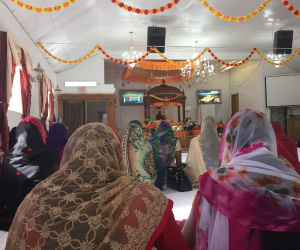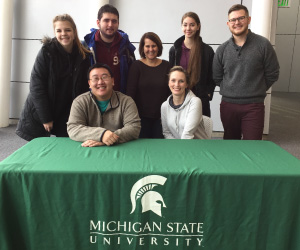Creating an Aural Record of Religion in the American Midwest

Gathering data for the American Religious Sounds Project
- Amy DeRogatis, Ph.D.
- Professor, Department of Religious Studies
- College of Arts and Letters
One Sunday early in April, a large group of people gathered in East Lansing to participate in an interfaith event, A Community Pilgrimage. The pilgrims gathered at Congregation Shaarey Zedek and made their way to the Islamic Center of East Lansing, with a stop at the Peoples Church of East Lansing, en route. They were accompanied by researcher Amy DeRogatis and a few of her students, who were gathering data for the American Religious Sounds Project, trying to capture the sounds of religion.
The project brings researchers and students together with communities of faith to explore the diversity of religious practice. It encourages participants to ask what makes a sound religious and to explore the boundaries between public and private expressions of faith.
Leading the program are Amy DeRogatis, professor of religion and American culture at Michigan State University, and Isaac Weiner, associate professor of religion and culture at Ohio State University. Truly co–principal investigators with a deep interest in learning more about religious expression in the American context, DeRogatis and Weiner bring different perspectives to the research at hand.
"My first book, Moral Geography, was on Protestant missionaries on the frontier," said Amy DeRogatis. "I looked at spatial data, at cartography and mapping and how Protestants used ideas about what a Christian space should look like to organize the frontier." Isaac Weiner, on the other hand, is the author of Religion Out Loud, which explores the intersection of religious sound and public space. The Religious Soundmap Project grew out of these complementary interests, resulting in the creation of a database of religious sounds and locating them on the map.
The initial phase of the project was funded by a $30,000 seed grant from the Humanities Without Walls consortium—based at Illinois Program for Research in the Humanities at University of Illinois at Urbana-Champaign—which was awarded to support research focused on the "global Midwest." That first grant funded two years of recording. The project is currently funded by a $200,000 grant from the Henry Luce Foundation.
The work of building relationships with willing faith communities, capturing sound recordings, and documenting and archiving is done primarily by students, under the guidance of DeRogatis and Weiner.
"We had to learn a lot of things," DeRogatis explained. "Not just how to do high quality field recordings, but also how to teach students to do field recordings. Then there was building relationships with community members, talking to them about what we're doing, asking them how what we're doing could be beneficial to them, figuring out how to work collaboratively, and learning about design and building websites."

American Religious Sounds Project participants
The two principal researchers run their own parallel programs at their respective universities for gathering information, but they are working together to create an online database accessible to the public. A pilot version of that future site has been developed by programmers at Michigan State, and the current Religious Soundmap Project page suggests what that final product might look like.
In addition to sound clips and the map coordinates, the growing archive also includes digital images. Many of these are taken by the project's official photographer at OSU, Lauren Pond, who also cleans up the audio files. Researchers also share their observations and reflect on their recording experiences on the project's blog page.
Weiner estimates there are three to four hundred clips ready to go up on the next version of the website. Looking ahead, he wants to expand how recordings are collected. "In terms of community engagement, the idea that I'm most excited about is that we'd like to sponsor a series of hands-on workshops at which we would train religious practitioners to record and document their own practices," Weiner said. "Rather than rely on recordings that our team of researchers have produced, we'd like to empower communities to tell their own stories."
To gather quality recordings of religious sounds, DeRogatis looks to two sources: expressions of religious belief in public spaces (e.g., street evangelists, spoken prayers given at rallies or protests, worship songs performed at local parks) and to the religious communities themselves.
Finding religious sound in public gatherings requires some legwork. DeRogatis and her students talk to people and comb newspapers to find community events, and then they have to show up with their equipment and listen. The latter requires the team to reach out to their networks. As a professor of religion, DeRogatis has been taking students to visit various places of worship since she began teaching at Michigan State, so there are already relationships there, but the pool has its limits.
"With this project, we are becoming very intentional about reaching out to groups that we haven't met before," DeRogatis said.
Making those connections and showing up, however, is only one piece. DeRogatis works with students to help them explore what makes a sound religious. Most people agree that church bells, congregational singing, and calls to prayer are religious sounds, but what about the hum of conversation heard during the after-service coffee hour? What about the shuffling of feet and occasional cough heard as the congregation finds their pew before mass begins? Can the sound of a baby crying be religious?
Additionally, DeRogatis presents a couple of ideas each semester to help broaden the definition of religious sound for her students. This semester, students were challenged to find sounds around the theme of food, so they have been capturing the sounds of fellowship meals and after-service coffee hours.
When the team is working with a specific community, members become participants in these discussions. Individuals have a chance to think about and share what sounds are significant to or emblematic of their own religious experience.
Recently, DeRogatis's students partnered with Sikh Gurdwara in Lansing. Harman Singh was asked by one of the gurdwara's committee members to work with the team from MSU and answer their questions.
"This was a good platform to show what Sikhism is about," Singh said. "We talked about how we are told to share and do charity, consider everyone equal and not discriminate against anyone on the basis of caste, race, gender, creed, origin, color, education, status, wealth, et cetera, how we believe in universal equality and brotherhood."
Singh also talked with the researchers about an expression of these beliefs, the gurdwara's langar. In Sikhism, the langar is a common kitchen where all visitors are served food, without cost.
The visits to the Sikh Gurdwara are an example of some of the project's deeper engagement. With this semester's focus on food, DeRogatis attended langar weekly.
"Most of the undergraduates are focusing on the food part," she said. "There's a campus hot dog ministry on Friday nights, where they're walking around with the people who are passing out the hot dogs and you know the good news. There are also scatter-shot events like the Episcopal Church's blessing of the animals."
"Many students end up not spending much time off campus, so it's an amazing learning experience," DeRogatis said. "It's lived religion. It brings the stuff to life, but also it gets them outside of the classroom, engaging with the community they live in. It's an incredibly powerful piece. That's what they're going to learn from my class. They many not remember the stuff I'm teaching them, but they will remember what it was like to go to the Haitian Methodist Church, and hear people speaking Creole."
- Written by Matt Forster, University Outreach and Engagement
- Photographs and images courtesy of Amy DeRogatis